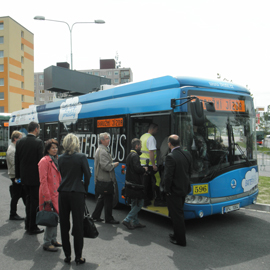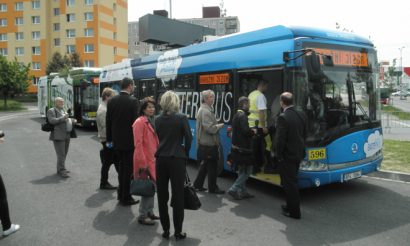A battery bus – definitely not “one-size-fits-all”
- Like
- Digg
- Del
- Tumblr
- VKontakte
- Buffer
- Love This
- Odnoklassniki
- Meneame
- Blogger
- Amazon
- Yahoo Mail
- Gmail
- AOL
- Newsvine
- HackerNews
- Evernote
- MySpace
- Mail.ru
- Viadeo
- Line
- Comments
- Yummly
- SMS
- Viber
- Telegram
- Subscribe
- Skype
- Facebook Messenger
- Kakao
- LiveJournal
- Yammer
- Edgar
- Fintel
- Mix
- Instapaper
- Copy Link
Posted: 4 August 2016 | Jakub Slavik, consultant | 5 comments
Jakub Slavik, a consultant in transportation and public service management, takes a look at battery bus procurement and insists there is not a “one-size-fits-all” option…




Battery electric buses are becoming popular in many European cities. They combine zero-emission operation of a trolley-bus with (at least partial) operational independence. A battery bus design, price and markets enable using standard public procurement procedures for their purchasing and operation, with possible contribution from the European Structural and Investment Funds (ESIF) – i.e. not just demonstration projects such as ZeEUS or current fuel cell bus projects. Despite this situation, a battery bus is definitely not a “one-size-fits-all” product.
Getting the right battery bus and charging technology
There is a big variety of vehicle configurations and charging concepts available. Getting the right vehicle and charging technology to the right place requires changing the product approach for the project approach with a sequence of steps in the project preparation stage that cannot be avoided. Let’s have a look at them closer, considering especially standard 12m buses as the most common bus type for urban service.
Which e-bus concept?
The key issue is: Where and how should the bus be operated and what is the expected daily mileage?
This will answer the principal question about the battery bus concept – an “overnight e-bus” charged just once a day with the battery capacity sufficient for the whole day shift or an “opportunity e-bus” with batteries recharged fast on the route.
The overnight e-bus concept using a standardised socket for its charging is a simple and robust solution wherever the required daily mileage does not exceed, say, 160 – 180 km. The e-bus usually offers as much space as a comparable diesel bus and its power consumption is still reasonable.
As soon as we get above the 180km required range, the choice becomes less clear.
There are obviously manufacturers offering even 250km range per single charging. However, a bus is primarily a device for carrying passengers. When filling it with batteries, the remaining space for passengers becomes limited and the power consumption per passenger place increases rapidly.
The opportunity charging concept then comes in question. As the carried battery capacity can be lower than by the overnight e-bus, the vehicle may offer more space for passengers. Furthermore, the unit power consumption is lower.
This concept, however, more or less pre-defines the e-bus operation area or routes and the buses lose their full operational independence. Sometimes a certain level of passenger discomfort and higher power consumption may be an acceptable “price” for retaining that independence or not resolving the opportunity charging issues.
There are additional opportunity charging concepts available. So, what’s the choice?
Inductive (contactless) charging such as that in Berlin offers almost no aesthetical impacts. It may, however, be a good source of various troubles as soon as the road surface above or around the charging plate needs to get repaired.
A non-grounded contact system using a bi-pole pantograph on the bus roof is employed in Vienna, for example. The trolley-bus or tram catenary is the power source by such systems and they are therefore likely to be the clear favourites if trolley-bus engineers become responsible for a battery bus project. The charging power, however, is quite limited by these systems. Also, the UN ECE 100 regulation requirements imply that placing a galvanic separation (simply: contactless power transfer) as a part of either the vehicle or the charging infrastructure is necessary here. The result is that such a “simple and cheap” solution may not be simple and cheap at all.
Grounded contact systems (often referred to as four-pole charging) use various mechanical consoles placed on vehicles or on the charging infrastructure, such as that in Hamburg. The charging process is automated, using M2M (machine-to-machine) communication between the vehicle and the charging device. The power source may be a DC substation as a part of the urban transit infrastructure (as in Dresden, for example) or a public AC network.
This is the only stream in the opportunity e-bus charging systems that (together with the overnight charging) is subject to the deliberate standardisation within the supplier industry and this process makes fast steps forward. Although there is a wide offer of many other technologies and concepts, it is worth pursuing and implementing those within the standardisation process. The story of the liked and hated Microsoft software may repeat: Surely there are more perfect systems, but this is the standard.
Not to forget: The old good socket may come in question for opportunity charging, too. If the timetable allows for, say, more than thirty minute break, why make things unnecessarily complicated and expensive? Well, if the drivers’ working conditions allow for that.
How about the suppliers?
So, now we precisely know what we want and it is time to go to the market and ask for it.
Issues related to professional culture may come in question by that. How often can I hear from transport operators’ engineers: “We were talking to the World-Class-Name Company people and we were told that they would make it for us just as we like”.
My dear engineering friends, nothing is impossible for the World-Class-Name Company’s engineers, indeed. Their sales people, however, will probably speak a slightly different language. They will be interested in the project size, the common or unique product requirements or the likely competitors and so on. They may asses your excellent idea as inadequate to the sunk cost or the business risk and decide not to take your promising chance.
It is therefore necessary to make the preliminary supplier market research, to stay in the real business world (and also, because the ESIF co-funding requires that).
Turnkey or separately?
If automated opportunity charging is chosen, the next question is: Tendering the vehicles and the charging infrastructure separately or together as a turnkey project?
The risk of the system unreliability, the likely project cost effectiveness, the tender administration demand and the risk of legal obstructions by the unsuccessful bidders should, at least, be carefully assessed by both alternatives, considering the project size and the level of experience by the operator.
System integration is always an issue wherever machines should talk to each other and co-operate. The worst possible position of a transport operator is becoming an arbiter between suppliers whose products refuse to work with each other.
So, simply speaking: a turnkey supply may be better for small projects, especially with the lack of relevant experience while separate tendering is the trend used by larger projects with proven technologies and experienced operators.
What next?
Getting as far as that, the project technological and operational definition should be summarised and the related project cash flows must be estimated and tested in a robust cost-benefit analysis, to make sure that the project is financially and socio-economically sound and worth public co-funding. Necessary additional costs such as new buildings etc. should not be forgotten by that.
If everything goes well, bingo! It is time to start with the tendering procedure. When asking for ESIF co-funding, the co-funding application comes in question beforehand.
Good luck!
|
Biography Jakub Slavik is an independent business consultant in transportation and public service management. |
Related topics
Air Quality, Alternative Power, Fleet Management & Maintenance, Transport Governance & Policy
Related modes
Bus & Coach









Another option is to use trolleybuses which also have batteries, so that they can recharge whilst in motion. Beijing is one of several cities which do this, as it allows for sections of wire-free travel and means that the buses can be available for passenger service at all times.
Battery buses which either opportunity charge or only charge at night are not available for service during the charging process. Whilst there are some fast charge battry solutions the reality is that the tchnology is still too new to know the likely long-term life of the batteries. Traditionally however fast charging has tended to shorten battery life.
Simon
This is a possibility, indeed, that would be worth a separate story (perhaps I should write it next time). Battery trolley buses are, simply speaking, a very good solution where
– the trolley infrastructure already exists,
– the proposed trolley-independent part of the vehicle circulation is not too long (as a rule of thumb – dependent : independent >= 2:1), and
– the trolley-independent part of the vehicle circulation does not differ too much from the trolley-dependent part in terms of the demand (i.e. the passenger flows).
Battery buses and battery trolley buses are not competitors, but rather complements. The overall project effectiveness is what decides about the optimum combination.
Jakub
Overnight charging probably doesn’t fit to most of the operational situations for PT operators as autonomy is too low (except where long breaks at course ends are foreseen which can be used for partial recharging).
So opportunity charging will be necessary for a PT operator wanting to use battery electric buses. The problem here is, as you said, that vehicles and infrastructure need to talk and to work together.
But what happens in the future? Life cycles of buses and (very expensive) infrastructure will be different. In a fast developing technological sector such as opportunity charging buses, will the then available buses still be able to fully cooperate with the existing (old) infrastructure? Will it be possible to well operate vehicles from different generations together with one infrastructure? Or will it be necessary to operate new generation buses in a reduced mode? Lot’s of questions operators should consider when interesting to this technology.
Thomas RÖHR
I wonder who would be able to respond to this question truly, objectively and comprehensively…
The fact is that opportunity charged e-buses have quite a short history. To my knowledge, the oldest operational opportunity e-buses are those in Turin with inductive charging, on duty since 2003. As consulted with the manufacturers, the opportunity charging infrastructure has its technical life about 15 years with some upgrade necessary after 10 years, an e-bus has its technical life about 12 years, while accounting lives of both are 10 years (according to our national legislation, at least). Surely the technology can make big steps within 10 or 15 years but some principal continuity has to be maintained.
I believe that the issue of technological and operational continuity should be resolved within the current standardization process under the CENELEC as started and supervised by the UITP.
Jakub
Opportunity charging, either at stops on route (during the passenger interchange time) or during layover periods at terminals, means a very substantial reduction in the mass of batteries to be carried. Hence there is a greater chance of being able to comply with allowable axle limits, and you are carrying around less unprofitable mass. But you are trying to transfer as much energy in 15 second chunks as you would normally transfer in 60 seconds of normal driving time, or you are transferring as much energy in 15 minutes of layover period as you would transfer in one hour en route. Your electricity supplier will have to provide cabling and other facilities for four times the current that a constant supply would need. He will charge extra – suppliers do not like sudden peak loads!
Probably the best option – apart from wiring the whole route – would be to use a combination of supercapacitors and batteries. The supercaps can take a fast charge with no problems – batteries do not like fast charging. The supercaps can transfer energy to batteries which have a better storage capacity.
Wiring the route is probably the best idea – but if there is sufficient demand to justify this then it is almost certain that it would be even better to lay tracks and run trams. Why was the Leeds trolleybus scheme cancelled!